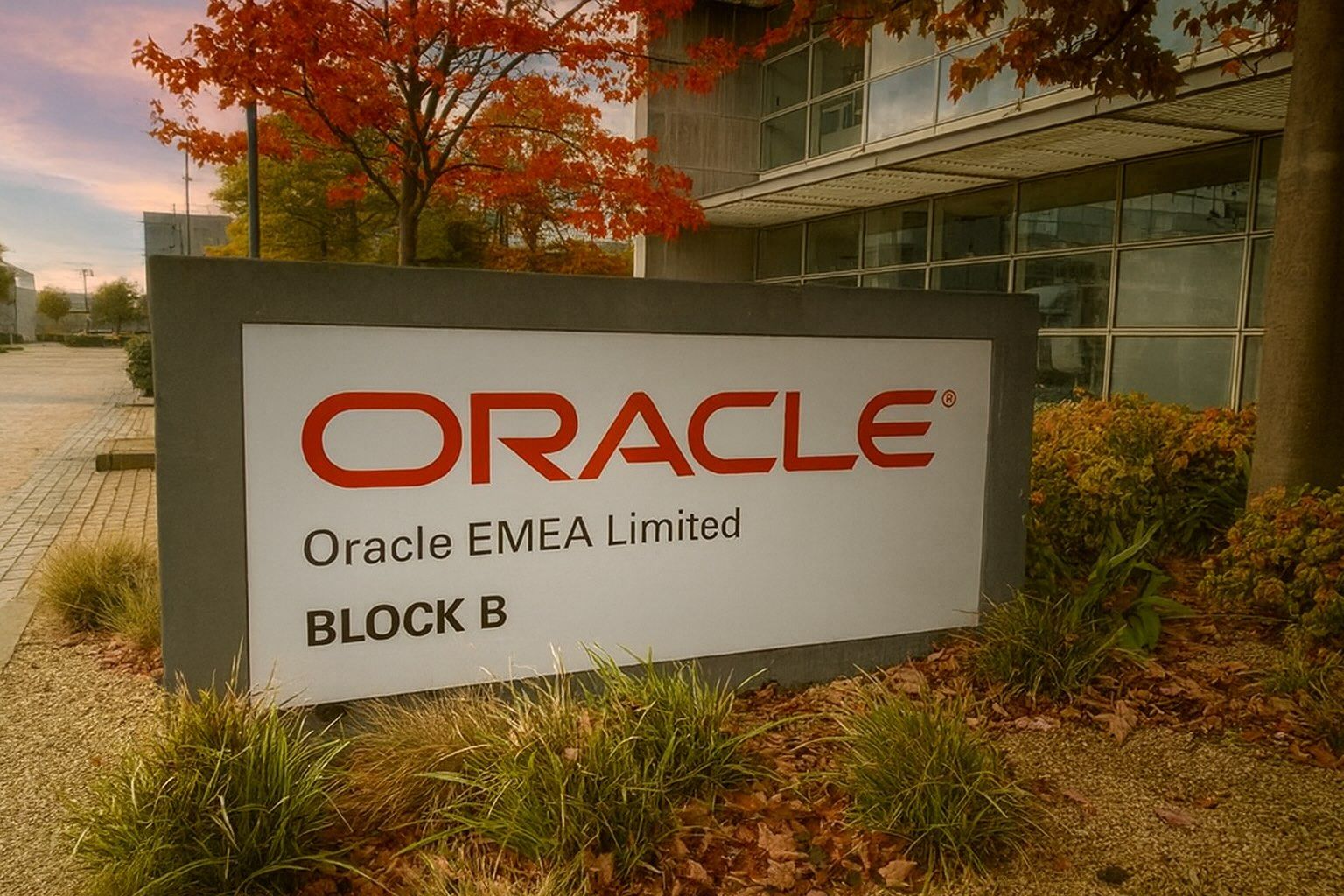Oracle stock is trying to stabilize on Wednesday after a bruising November, as investors digest fresh AI‑cloud expansion news, new trading products tied to the shares and ongoing worries about debt‑funded infrastructure spending.
As of mid‑afternoon U.S. trading on November 19, Oracle Corporation (NYSE: ORCL) was changing hands around $224.78, up about 2% on the day, after opening at $218 and trading between roughly $217.5 and $228.1.
Quick snapshot: ORCL on November 19, 2025
- Price today: ~$224.8, up about $4.3 vs. Tuesday’s close of $220.49. Ts2 Tech
- Range: intraday low near $217.5, high just above $228.
- Market value: around $630–640 billion, with roughly 2.85 billion shares outstanding. [1]
- Valuation: trades at about 51–52x trailing earnings and ~32x forward earnings, versus a dividend yield of ~0.9% on a $2.00 annual payout. [2]
- 52‑week context: about 35% below its 52‑week (and record) high near $345.7, but still almost 90% above its 12‑month low of $118.9. [3]
- Momentum: up 32.8% year‑to‑date, yet down 24.3% over the past month and 6.6% over the past week, underscoring how violently sentiment has swung. [4]
At a high level, today’s story is a tug‑of‑war: positive headlines about cloud and AI breadth versus unease about leverage and AI spending.
1. Oracle stock price today: attempting a bounce after a sharp pullback
After a blockbuster run into early September, Oracle’s share price has retreated sharply. By today, the stock has been down as much as about 35–37% from its peak, according to credit‑market commentary and recent price history. [5]
Despite that correction, fundamental metrics look like this:
- Trailing P/E: ~51–52x
- Forward P/E: ~32x
- Dividend yield: ~0.9% (annual dividend $2.00; last ex‑dividend date October 9, 2025) [6]
So ORCL today is not cheap on traditional metrics, even after a big pullback, which is why valuation—and how much AI growth can justify it—is front and center in almost every piece of analysis published on November 19.
2. Today’s biggest fundamental catalyst: second Oracle Cloud region in Italy
The clearest “hard news” item for Oracle today is a fresh expansion of its AI‑ready cloud footprint in Europe:
- Oracle announced the opening of the Oracle Cloud Turin Region, its second public cloud region in Italy after Milan.
- The region, hosted with Telecom Italia, is aimed at AI workloads, multicloud architectures and sovereign‑cloud requirements for regulated customers. [7]
According to Oracle’s own release, the Turin region:
- Brings the full Oracle Cloud Infrastructure (OCI) services stack—including generative AI services, the OCI AI Agent Platform and Oracle AI Data Platform—closer to Italian enterprises, startups and the public sector. [8]
- Is designed to help customers keep data within Italian or EU borders, an increasingly important issue for government, healthcare and financial‑services workloads. [9]
A pre‑market note on ORCL from TechStock² framed the new region as incremental capacity that supports Oracle’s AI‑bookings narrative and strengthens its pitch around EU data residency and sovereign AI—both of which matter when competing for government and highly regulated contracts. Ts2 Tech
Why it matters for the stock:
- The Italy move shows Oracle is still in “build‑out mode” for AI infrastructure, not retrenching despite debt concerns.
- It adds a concrete data point to the bull case that Oracle can win high‑value AI and cloud workloads in Europe, not just in the U.S.
- For bears, it’s further evidence that capital‑intensive data‑center build‑outs will continue, which keeps leverage and cash‑flow timing in focus.
3. AI credibility boost: RiskTech AI 50 award in financial services
Also hitting the tape today: Oracle Financial Services was named the “Overall Winner” in the Chartis RiskTech AI 50 2025 ranking—for the second straight year. [10]
Key details from the Chartis/Oracle announcement:
- Oracle topped the list of 50 vendors evaluated and led in innovation, strategy and impact categories. [11]
- Chartis highlighted Oracle’s AI‑enabled risk, finance and compliance platforms, and its ability to deploy AI at scale on high‑performance, low‑latency cloud infrastructure for banks and insurers. [12]
For equity investors, the takeaway is less about immediate revenue and more about brand and proof‑points:
- It reinforces the idea that Oracle’s AI push is not only about raw compute and GPUs, but also about vertical applications (in this case, financial‑risk and compliance solutions) where the company already has deep customer relationships.
- It gives bulls another credential to cite when arguing Oracle can convert AI infrastructure into sticky, high‑margin software and services revenue over time.
4. Cloud security ecosystem: Orca Security joins Oracle Cloud Marketplace
On the ecosystem front, Orca Security announced today that its cloud‑native application protection platform (CNAPP) is now available on Oracle Cloud Marketplace and can be deployed on OCI. [13]
Highlights from that release:
- Orca provides agentless, full‑stack visibility and risk detection across workloads, identities and configurations, using its SideScanning technology. [14]
- It emphasizes continuous compliance with standards such as NIST, SOC 2, ISO 27001, GDPR and HIPAA—key selling points for heavily regulated industries that Oracle targets. [15]
While this is a relatively small piece of news in dollar terms, it underscores a trend: Oracle is courting security partners to make OCI more attractive for enterprises that want consolidated AI, data and security capabilities on one cloud platform.
5. Wall Street view today: “Moderate Buy” with high targets and noisy debate
Consensus ratings and targets
A fresh MarketBeat survey published November 19 finds that 42 analysts covering Oracle now give it a consensus “Moderate Buy” rating:
- 2 “sell”
- 10 “hold”
- 27 “buy”
- 3 “strong buy”
The average 12‑month price target sits around $322.3, which is roughly 40–45% above today’s trading level. [16]
MarketBeat also summarizes recent quarterly results:
- EPS of $1.47 vs. $1.48 expected, and revenue of $14.93 billion vs. $15.04 billion consensus, a small miss on both lines.
- Oracle guided Q2 FY26 EPS to $1.27–1.31 and continues to point to strong demand for AI‑driven cloud infrastructure. [17]
Baird vs. Jefferies: cautious trim vs. aggressive upside
Part of today’s narrative comes from dueling analyst notes:
- Baird recently cut its price target to $315 from $365 but kept an Outperform rating, citing a constructive long‑term thesis but near‑term concern over the pace of AI build‑out and leverage. Ts2 Tech+1
- Jefferies, by contrast, has a $400 price target and has argued that worries about debt and customer concentration are overdone, with room for as much as ~80% upside from depressed levels if Oracle executes on its AI roadmap. Ts2 Tech+1
Put together, these calls explain why the headline consensus is bullish, but the debate is intense—which is exactly what you’d expect for a mega‑cap stock that has fallen more than a third from its highs while still trading on a rich multiple.
Zacks: Oracle is a “trending stock”
Separately, Zacks highlighted Oracle as a “trending stock” on its platform today, noting that ORCL has seen elevated interest from Zacks.com users and flagging it for deeper fundamental review. [18]
That kind of attention often correlates with higher retail engagement and can add an extra layer of short‑term volatility.
6. Valuation debate: is the AI premium justified?
A detailed valuation breakdown from Simply Wall St—also dated November 19—captures today’s core question: is Oracle fairly valued or priced for perfection after its wild swings? [19]
Key points from their analysis:
- Performance swings:
- Up 32.8% year‑to‑date,
- Down 24.3% over the last month,
- Down 6.6% over the last week. [20]
- Discounted Cash Flow (DCF): they estimate an intrinsic value of about $212.7 per share, only ~3–4% below today’s price, and classify the stock as “about right” on this metric. [21]
- P/E comparison: Oracle’s P/E around 50.5x is well above the broader software industry average of ~30x, yet below a peer group average near 71x. In their model, a “fair” P/E for Oracle, given its growth and risk profile, is about 61.9x, again suggesting valuation is elevated but not extreme relative to their assumptions. [22]
They also frame the bull vs. bear narratives numerically:
- Bull case: fair value in the mid‑$300s, with revenue growth above 30% driven by AI cloud demand and margin expansion.
- Bear case: fair value just above $210, with mid‑teens growth, more competition from AWS/Azure/Google, and persistent balance‑sheet worries. [23]
In short, on November 19 the valuation debate is less about whether Oracle is “cheap” and more about which growth narrative you believe.
7. Debt, bonds and credit default swaps: the other big story
If the cloud expansion is the good news, the credit‑market story is the dark cloud over Oracle this month—and it’s very much part of today’s coverage.
An Investing.com analysis published overnight calls Oracle’s debt markets “the most important chart in AI today,” noting that: [24]
- Oracle shares are down around 37% from their record high, with bond prices sliding as investors react to reports that the company plans to add roughly $38 billion in new debt to fund AI and cloud infrastructure.
- 5‑year credit default swap (CDS) spreads on Oracle have widened, a sign that investors are paying more to insure against default—even though the company remains investment‑grade and absolute default risk is still considered low.
- Some investors now treat Oracle’s credit spreads as a proxy for broader AI‑infrastructure risk: if a mega‑cap like Oracle is seeing credit costs jump, what does that say about the sustainability of the AI spending boom?
At the same time, BofA analyst Brad Sills is quoted emphasizing that Oracle is structuring many AI compute deals as non‑cancelable, take‑or‑pay contracts, which are intended to support stable, visible cash flows that can service the new debt. [25]
Add in a Reuters‑flagged bond sell‑off tied to the same planned $38 billion debt increase, and it’s clear why debt and CDS charts are now part of the Oracle equity story. [26]
8. New leveraged ETFs and options activity: traders pile in
Today also marks the launch of direct trading vehicles linked to Oracle’s daily moves:
- Direxion introduced five new single‑stock leveraged and inverse ETFs, including:
- Direxion Daily ORCL Bull 2X ETF (ORCU)
- Direxion Daily ORCL Bear 1X ETF (ORCS) [27]
Direxion explicitly positions these products as short‑term trading tools intended for experienced active traders with high risk tolerance, not buy‑and‑hold vehicles. They track the daily percentage move in Oracle stock (magnified for the bull fund), which means performance can diverge significantly from the underlying over longer periods. [28]
Meanwhile, a Nasdaq/BNK Invest note today highlights a covered‑call strategy on Oracle: [29]
- Selling the December 2027 $360 call against ORCL shares at a quoted $34.90 bid, on top of the stock’s 0.9% dividend yield.
- Based on their math, this boosts the annualized yield to ~8.4%, assuming the stock is not called away.
- They estimate ORCL would need to rally about 60.6% from current levels to hit $360 by expiration, implying a 76% total return if called away, plus dividends.
- They also peg Oracle’s trailing 12‑month volatility at around 57%, underscoring just how bumpy this ride has been.
Again, that’s not a recommendation—just evidence that both retail and institutional options traders are actively using ORCL to express bullish and income‑oriented views.
9. Ownership flows: institutional buying vs. insider and political selling
Institutions still adding
A separate MarketBeat piece today notes that Primecap Management Co. CA increased its Oracle stake by about 3.8% in Q2, buying roughly 405,525 additional shares: [30]
- Primecap now owns about 11.18 million ORCL shares, or 0.40% of the company, valued around $2.44 billion, making Oracle its 11th‑largest position at ~1.9% of its portfolio. [31]
- Several smaller advisers also added positions, and in total about 42.4% of Oracle’s float is held by hedge funds and other institutional investors. [32]
That ongoing institutional interest provides a counterweight to the negative headlines around debt and credit spreads.
Insider and political selling
However, not all flows are one‑way:
- MarketBeat’s consensus‑rating article and a separate insider‑trading update highlight that insiders sold about 204,254 Oracle shares (≈$60.2 million) over the last quarter, including notable transactions by EVP Stuart Levey and director Jeffrey Berg, even though insiders still own roughly 40.9% of the company. [33]
- Another November 19 report notes that Sen. Tommy Tuberville (R‑Alabama) disclosed selling between $15,001 and $50,000 of Oracle stock on October 7, alongside similar‑sized sales of Apple, Microsoft, Alphabet, PepsiCo and Owens Corning. The article frames the trades as modest relative to Oracle’s size but part of a broader discussion around political stock trading. [34]
These flows don’t automatically mean “smart money is bearish” or bullish, but they do add nuance to the ownership picture at a time when many investors are scrutinizing who is buying or selling into AI volatility.
10. Broader media narrative: spending too much on AI?
Beyond Oracle‑specific releases, several broader market stories today put ORCL at the center of a larger AI spending debate:
- A Barron’s piece titled “Oracle and Other AI Stocks Are Spending Too Much Cash. These Companies Are Returning It in Spades.” argues that since late October, companies that return large amounts of cash via buybacks and dividends have outperformed heavy spenders, with Oracle mentioned among AI firms whose aggressive investment is under scrutiny. [35]
- Other coverage points to Oracle’s stock shedding roughly $374 billion in market value since its much‑discussed $300 billion AI compute deal with OpenAI, emphasizing how high expectations were—and how quickly sentiment can reverse. [36]
Taken together with the CDS and bond stories, today’s cross‑current is clear:
The market is still trying to decide whether Oracle’s AI spending is visionary or excessive, and the stock is repricing in real time as that debate plays out.
11. Recent fundamentals backdrop: AI cloud growth vs. guidance jitters
All of this sits on top of Oracle’s latest reported quarter:
- For its most recent fiscal Q1 (reported September 9), Oracle posted:
- Revenue of $14.93 billion, up about 12% year over year, slightly below Wall Street’s ~$15.04 billion expectation.
- EPS of $1.47 vs. $1.48 consensus. [37]
- Cloud revenue (IaaS + SaaS) was a key bright spot, growing around 28% year over year to roughly $7.2 billion, and Oracle highlighted an enormous remaining performance obligation (RPO) of $455 billion, up 359% year on year, helped by long‑term AI capacity contracts. [38]
Guidance for the current quarter—Q2 FY26, with a consensus earnings date around December 8, 2025 on many calendars—calls for EPS of $1.27–1.31. Oracle itself, however, is still guiding more generically to mid‑December for the next earnings release, so investors are watching for a formal date from Investor Relations. Ts2 Tech+1
12. What all this means for Oracle investors on November 19, 2025
Putting today’s headlines together, the Oracle story on November 19 looks like this:
Positives:
- Concrete AI‑cloud expansion in Italy (Turin) strengthens Oracle’s European footprint and its sovereign‑cloud and AI narrative. [39]
- Recognition in financial‑services AI via the Chartis RiskTech AI 50 award supports Oracle’s positioning as not just another GPU landlord but a provider of advanced, regulated‑industry solutions. [40]
- The ecosystem is broadening—with security partners like Orca, institutional buyers such as Primecap, and new tools for traders (leveraged ETFs and covered‑call opportunities). [41]
- Wall Street’s consensus stance remains “Moderate Buy” to “Buy”, with average targets in the low‑to‑mid‑$300s, implying significant potential upside if Oracle’s AI cloud plan works. [42]
Risks and overhangs:
- Debt and credit risk have moved to the foreground. Plans to add tens of billions in new debt, alongside rising CDS spreads and bond‑market stress, are unusual for a company of Oracle’s size and are clearly weighing on sentiment. [43]
- High valuations (P/E around 50x) mean the stock is still priced for meaningful growth, even after a one‑third drop from its highs. [44]
- A noticeable amount of insider selling, plus small but visible sales by a U.S. senator, feed a narrative—fair or not—that some sophisticated players are taking chips off the table into volatility. [45]
Near‑term catalyst:
- The next major checkpoint is Oracle’s fiscal Q2 FY26 earnings in mid‑December, when management will have to reconcile the AI growth story with the new reality of higher debt and tighter credit spreads. Ts2 Tech+2StockAnalysis+2
13. Final word (and a quick disclaimer)
On November 19, 2025, Oracle stock is caught between two stories:
- A fast‑growing AI and cloud franchise, expanding into new regions like Turin and earning accolades for its AI‑powered financial and healthcare solutions.
- A capital‑intensive, debt‑heavy infrastructure build‑out that has made bondholders nervous and forced equity investors to re‑evaluate how much they’re willing to pay for that growth.
Whether ORCL at roughly $225 is a bargain or a value trap will depend on how you weigh those forces—and on what Oracle delivers at its next earnings update.
This article is for informational purposes only and does not constitute investment advice, a recommendation, or a solicitation to buy or sell any security. Always do your own research and consider speaking with a licensed financial advisor before making investment decisions.
References
1. www.marketbeat.com, 2. www.marketbeat.com, 3. www.marketbeat.com, 4. simplywall.st, 5. ph.investing.com, 6. www.marketbeat.com, 7. www.oracle.com, 8. www.oracle.com, 9. www.oracle.com, 10. www.oracle.com, 11. www.oracle.com, 12. www.oracle.com, 13. www.businesswire.com, 14. www.businesswire.com, 15. www.businesswire.com, 16. www.marketbeat.com, 17. www.marketbeat.com, 18. sg.finance.yahoo.com, 19. simplywall.st, 20. simplywall.st, 21. simplywall.st, 22. simplywall.st, 23. simplywall.st, 24. ph.investing.com, 25. ph.investing.com, 26. stockanalysis.com, 27. markets.businessinsider.com, 28. markets.businessinsider.com, 29. www.nasdaq.com, 30. www.marketbeat.com, 31. www.marketbeat.com, 32. www.marketbeat.com, 33. www.marketbeat.com, 34. www.marketbeat.com, 35. www.barrons.com, 36. www.tipranks.com, 37. www.marketbeat.com, 38. investor.oracle.com, 39. www.oracle.com, 40. www.oracle.com, 41. www.businesswire.com, 42. www.marketbeat.com, 43. ph.investing.com, 44. simplywall.st, 45. www.marketbeat.com







